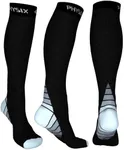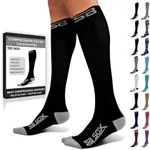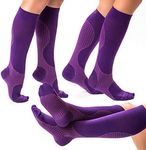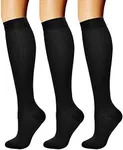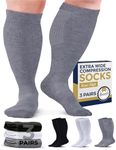Buying Guide for the Best Medical Compression Socks
Medical compression socks are designed to improve blood flow, reduce swelling, and alleviate discomfort in the legs. They are commonly used by individuals with conditions such as varicose veins, deep vein thrombosis, or those who spend long periods standing or sitting. Choosing the right pair of compression socks involves understanding various specifications to ensure they meet your specific needs and provide the desired benefits.Compression LevelCompression level refers to the amount of pressure the socks apply to your legs, measured in millimeters of mercury (mmHg). This is important because different levels of compression are suitable for different conditions and needs. Light compression (8-15 mmHg) is typically used for mild swelling and fatigue, moderate compression (15-20 mmHg) for varicose veins and pregnancy, firm compression (20-30 mmHg) for moderate to severe varicose veins and post-surgery, and extra firm compression (30-40 mmHg) for severe swelling and chronic venous insufficiency. To pick the right one, consider your medical condition and consult with a healthcare professional if necessary.
SizeSize is crucial for the effectiveness and comfort of compression socks. Properly fitting socks ensure the right amount of compression is applied evenly. Sizes are usually determined by measuring the circumference of your ankle, calf, and sometimes thigh, as well as the length of your leg. Sizes can vary between brands, so always refer to the specific sizing chart provided by the manufacturer. To pick the right size, measure your legs accurately and choose the size that matches your measurements.
MaterialThe material of compression socks affects their comfort, durability, and breathability. Common materials include nylon, spandex, and cotton blends. Nylon and spandex provide good elasticity and durability, while cotton blends offer more comfort and breathability. To pick the right material, consider your skin sensitivity, the climate you live in, and how long you will be wearing the socks each day. For example, if you have sensitive skin, you might prefer a cotton blend, while if you need durable socks for long-term use, nylon and spandex might be better.
LengthCompression socks come in various lengths, including knee-high, thigh-high, and full-length (pantyhose). The length you choose depends on the area of your leg that needs support. Knee-high socks are suitable for most conditions affecting the lower leg, while thigh-high and full-length options provide support for the entire leg and are often used for more severe conditions. To pick the right length, consider the specific area of your leg that requires compression and any recommendations from your healthcare provider.
Open or Closed ToeCompression socks are available with either open or closed toes. Open-toe socks allow more breathability and can be more comfortable in warmer weather or for individuals with toe conditions. Closed-toe socks provide full coverage and are often preferred for colder climates or for those who want more comprehensive support. To pick the right option, consider your personal comfort preferences, the climate you live in, and any specific foot conditions you may have.
